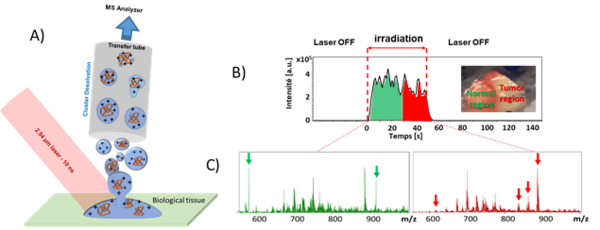Michael Ziskind & Cristian Focsa (PhLAM)
Isabelle Fournier & Michel Salzet (PRISM)
The period 2013-2018 was marked by the development of a research axis initiated in 2010 between our group and the biology laboratory PRISM (INSERM U 1192, Lille). Its objective is to design original tools for biological and medical diagnostics, based on the coupling of laser ablation and mass spectrometry (MS) techniques. The first steps of this research axis are the development and optimization of two devices simultaneously improving sensitivity and spatial resolution of MALDI analyzes: the silicon masks [DIO, 2014] (IF>6) and the laser induced post-desolvation technique [DIO, 2017], respectively. It continues with the implementation of a new tool for tissue micro-sampling by laser ablation at ambient pressure and temperature [FAT 2015] (IF>4). The main challenge is to propose a device compatible with in-vivo analysis under an intraoperative context. Currently, only the Intelligent Knife (iKnife) system allowed real-time monitoring during surgery by collecting aerosol released during tissue excision with an electric scalpel or bipolar forceps [Balog, J. et al.. Sci Transl Med 5, 194ra193 (2013)]. In this context, we have developed a new instrument (called SpiderMass) for in vivo and real-time analysis based on the resonant laser ablation of the water molecules naturally present in most biological samples. The generated ions are transported by aspiration to the MS analyzer. The retrieved molecular patterns (metabolites and lipids) are specific to the cell phenotypes and benign versus cancer regions of patient biopsies can be easily differentiated. We also demonstrated by analyzing human skin that SpiderMass can be used under in vivo conditions (Fig. 3) with minimal damage and pain compared to the iKnife system. Therefore, it should provide a solution that can help fast intraoperative decisions. Furthermore, it can also be used for real-time drug metabolism and pharmacokinetic (DMPK) analysis or food safety related topics [FAT, 2016] (IF>4). These preliminary results, obtained with a first prototype, enabled the filing of a patent (2014, ext. PCT 2016 [SAL, 2014]) and the support by grants from ANR Santé Bien-être (Reality’MS, 2014-2018) and Inserm PhysiCancer (SpiderMass, 2015-2018). Its valorization started in 2015 when our project was awarded ‘best breakthrough innovation’ by the MATWIN international board that gathered academic institutions and international industrial leaders in pharmacology and oncology (GSK, Roche, Sanofi, Merck, Pierre Fabre, Bayer Health Care, Novartis…). It continues today through the SATT Nord maturation program (2016-2018). In this context, we have developed a second prototype, portable and fibered, currently being routinely used on the project. We also extend its capability to detect and analyze peptides and proteins [FAT 2018a] (IF>6). Our Technique Readiness Level (TRL) has since risen from 1 to 6.

The next step is to test the device in a surgery room in veterinary clinic Oncovet (Villeneuve d’Ascq). For this purpose, benchmark studies to establish molecular profiles banks associated with a pathology type – dog sarcoma – together with the development of a real-time query interface have been successfully initiated in collaboration with Oncovet and the Department of Surgery and Cancer of the Imperial College (London) (article under review in Cancer Cell (IF>27)). The construction of a human pathology (ovarian cancer) grade classification model is also undertaken in collaboration with the Cancer Center Oscar Lambret and the Hôpital Jeanne de Flandre (Lille). In the meantime, we plan to outspread the technique’s applications to other fields that could benefit from it: pharmaceutical and environmental science, as well as geology [FAT, 2018b].
The objective of the project is a commercial exploitation of the device, through the creation of a start-up. First positive contacts with technology incubators and investors have been made in this direction. Partnerships with companies like Pierre Fabre (dermatology) or Opotek (laser sources) and Waters (MS analyzer) have also been established.